Literature Review: Green Composites in Environmental Engineering
VerifiedAdded on 2020/04/07
|29
|7024
|265
Report
AI Summary
This report presents a comprehensive literature review on green composites, biocomposites made with natural fibers and bio-based polymer resins. It covers the classification of green composites based on reinforcement type (fibrous, continuous fiber, discontinuous fiber, particulate, filler, flake, laminated, and hybrid composites), highlighting their attributes and advantages such as biodegradability, low energy consumption, and recyclability. The review delves into various manufacturing methods including open molding, closed molding, autoclave bonding, and rapid prototyping. Furthermore, the report explores the wide range of applications of green composites in transportation, aerospace, sports, electronics, healthcare, construction, packaging, and energy sectors. It also addresses the concerns related to these materials, such as the need for fiber modification to improve compatibility and address hydrophilic properties. The methodology section outlines the approach to making a green composite panel and determining its mechanical properties. The report concludes by emphasizing the importance of green composites in sustainable development and their increasing adoption across various industries. The report is designed to provide a thorough understanding of the field for those interested in environmental engineering and materials science, and is available on Desklib.
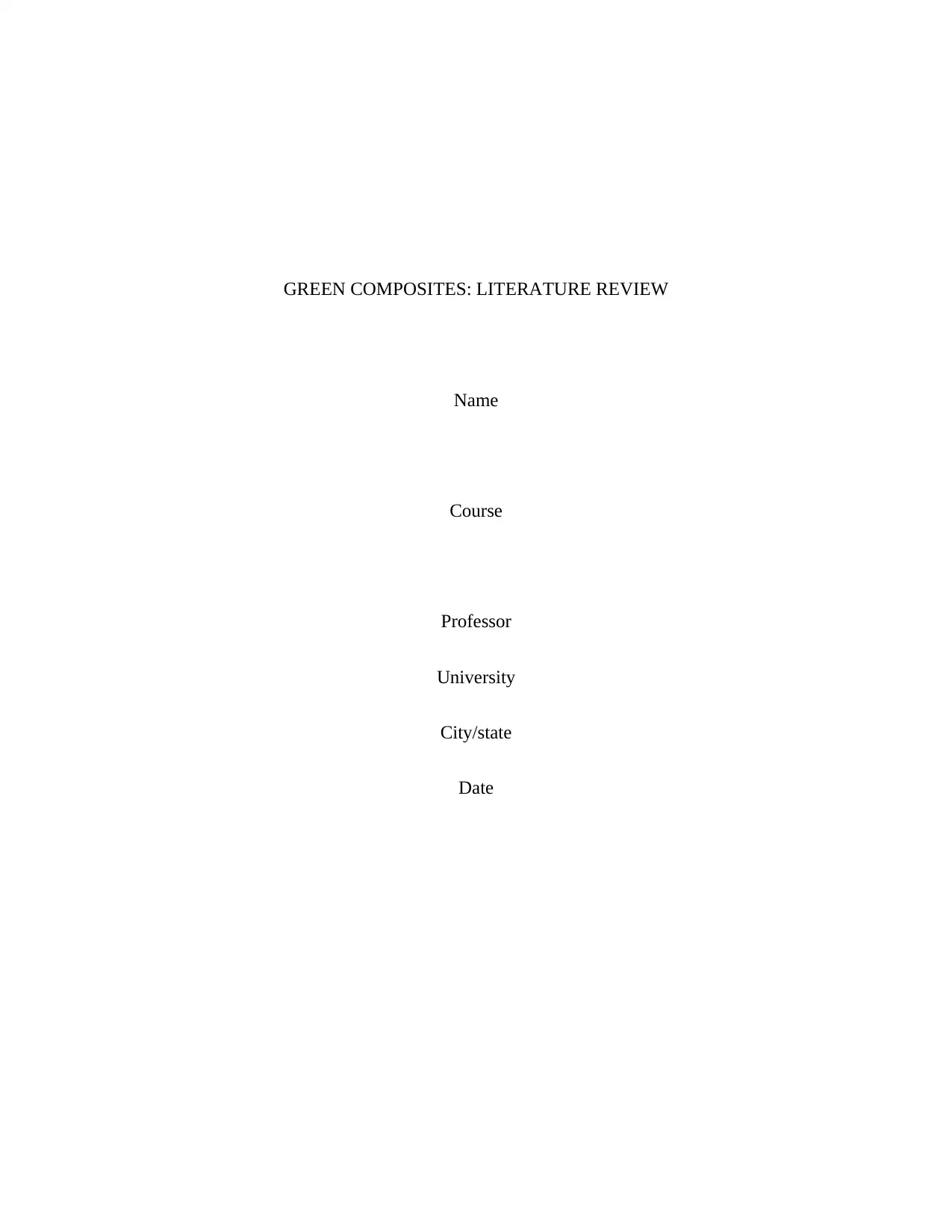
GREEN COMPOSITES: LITERATURE REVIEW
Name
Course
Professor
University
City/state
Date
Name
Course
Professor
University
City/state
Date
Paraphrase This Document
Need a fresh take? Get an instant paraphrase of this document with our AI Paraphraser
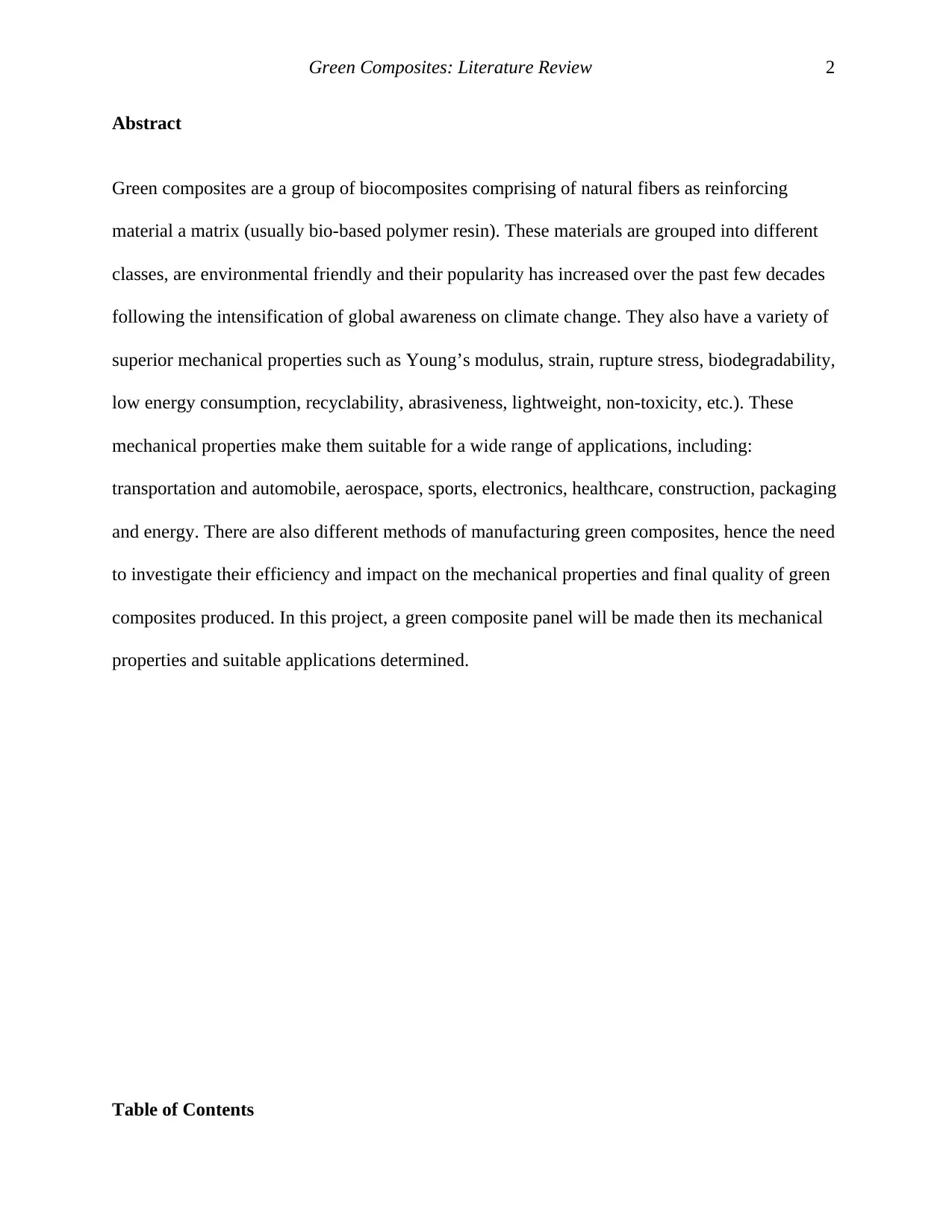
Green Composites: Literature Review 2
Abstract
Green composites are a group of biocomposites comprising of natural fibers as reinforcing
material a matrix (usually bio-based polymer resin). These materials are grouped into different
classes, are environmental friendly and their popularity has increased over the past few decades
following the intensification of global awareness on climate change. They also have a variety of
superior mechanical properties such as Young’s modulus, strain, rupture stress, biodegradability,
low energy consumption, recyclability, abrasiveness, lightweight, non-toxicity, etc.). These
mechanical properties make them suitable for a wide range of applications, including:
transportation and automobile, aerospace, sports, electronics, healthcare, construction, packaging
and energy. There are also different methods of manufacturing green composites, hence the need
to investigate their efficiency and impact on the mechanical properties and final quality of green
composites produced. In this project, a green composite panel will be made then its mechanical
properties and suitable applications determined.
Table of Contents
Abstract
Green composites are a group of biocomposites comprising of natural fibers as reinforcing
material a matrix (usually bio-based polymer resin). These materials are grouped into different
classes, are environmental friendly and their popularity has increased over the past few decades
following the intensification of global awareness on climate change. They also have a variety of
superior mechanical properties such as Young’s modulus, strain, rupture stress, biodegradability,
low energy consumption, recyclability, abrasiveness, lightweight, non-toxicity, etc.). These
mechanical properties make them suitable for a wide range of applications, including:
transportation and automobile, aerospace, sports, electronics, healthcare, construction, packaging
and energy. There are also different methods of manufacturing green composites, hence the need
to investigate their efficiency and impact on the mechanical properties and final quality of green
composites produced. In this project, a green composite panel will be made then its mechanical
properties and suitable applications determined.
Table of Contents
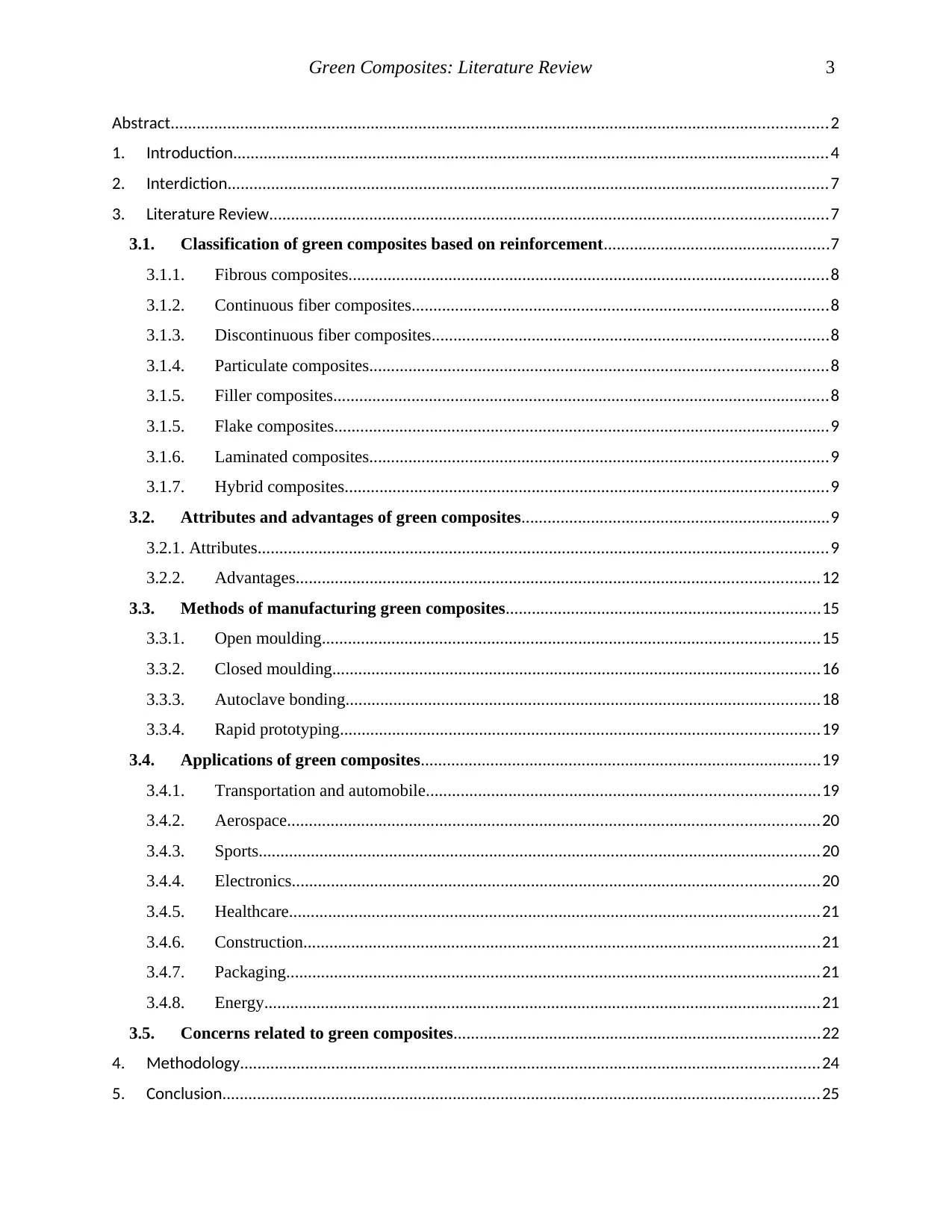
Green Composites: Literature Review 3
Abstract.......................................................................................................................................................2
1. Introduction.........................................................................................................................................4
2. Interdiction..........................................................................................................................................7
3. Literature Review................................................................................................................................7
3.1. Classification of green composites based on reinforcement....................................................7
3.1.1. Fibrous composites..............................................................................................................8
3.1.2. Continuous fiber composites................................................................................................8
3.1.3. Discontinuous fiber composites...........................................................................................8
3.1.4. Particulate composites.........................................................................................................8
3.1.5. Filler composites..................................................................................................................8
3.1.5. Flake composites..................................................................................................................9
3.1.6. Laminated composites.........................................................................................................9
3.1.7. Hybrid composites...............................................................................................................9
3.2. Attributes and advantages of green composites.......................................................................9
3.2.1. Attributes...................................................................................................................................9
3.2.2. Advantages........................................................................................................................12
3.3. Methods of manufacturing green composites........................................................................15
3.3.1. Open moulding..................................................................................................................15
3.3.2. Closed moulding................................................................................................................16
3.3.3. Autoclave bonding.............................................................................................................18
3.3.4. Rapid prototyping..............................................................................................................19
3.4. Applications of green composites............................................................................................19
3.4.1. Transportation and automobile..........................................................................................19
3.4.2. Aerospace..........................................................................................................................20
3.4.3. Sports.................................................................................................................................20
3.4.4. Electronics.........................................................................................................................20
3.4.5. Healthcare..........................................................................................................................21
3.4.6. Construction.......................................................................................................................21
3.4.7. Packaging...........................................................................................................................21
3.4.8. Energy................................................................................................................................21
3.5. Concerns related to green composites....................................................................................22
4. Methodology.....................................................................................................................................24
5. Conclusion.........................................................................................................................................25
Abstract.......................................................................................................................................................2
1. Introduction.........................................................................................................................................4
2. Interdiction..........................................................................................................................................7
3. Literature Review................................................................................................................................7
3.1. Classification of green composites based on reinforcement....................................................7
3.1.1. Fibrous composites..............................................................................................................8
3.1.2. Continuous fiber composites................................................................................................8
3.1.3. Discontinuous fiber composites...........................................................................................8
3.1.4. Particulate composites.........................................................................................................8
3.1.5. Filler composites..................................................................................................................8
3.1.5. Flake composites..................................................................................................................9
3.1.6. Laminated composites.........................................................................................................9
3.1.7. Hybrid composites...............................................................................................................9
3.2. Attributes and advantages of green composites.......................................................................9
3.2.1. Attributes...................................................................................................................................9
3.2.2. Advantages........................................................................................................................12
3.3. Methods of manufacturing green composites........................................................................15
3.3.1. Open moulding..................................................................................................................15
3.3.2. Closed moulding................................................................................................................16
3.3.3. Autoclave bonding.............................................................................................................18
3.3.4. Rapid prototyping..............................................................................................................19
3.4. Applications of green composites............................................................................................19
3.4.1. Transportation and automobile..........................................................................................19
3.4.2. Aerospace..........................................................................................................................20
3.4.3. Sports.................................................................................................................................20
3.4.4. Electronics.........................................................................................................................20
3.4.5. Healthcare..........................................................................................................................21
3.4.6. Construction.......................................................................................................................21
3.4.7. Packaging...........................................................................................................................21
3.4.8. Energy................................................................................................................................21
3.5. Concerns related to green composites....................................................................................22
4. Methodology.....................................................................................................................................24
5. Conclusion.........................................................................................................................................25
⊘ This is a preview!⊘
Do you want full access?
Subscribe today to unlock all pages.

Trusted by 1+ million students worldwide

Green Composites: Literature Review 4
References.................................................................................................................................................25
1. Introduction
References.................................................................................................................................................25
1. Introduction
Paraphrase This Document
Need a fresh take? Get an instant paraphrase of this document with our AI Paraphraser
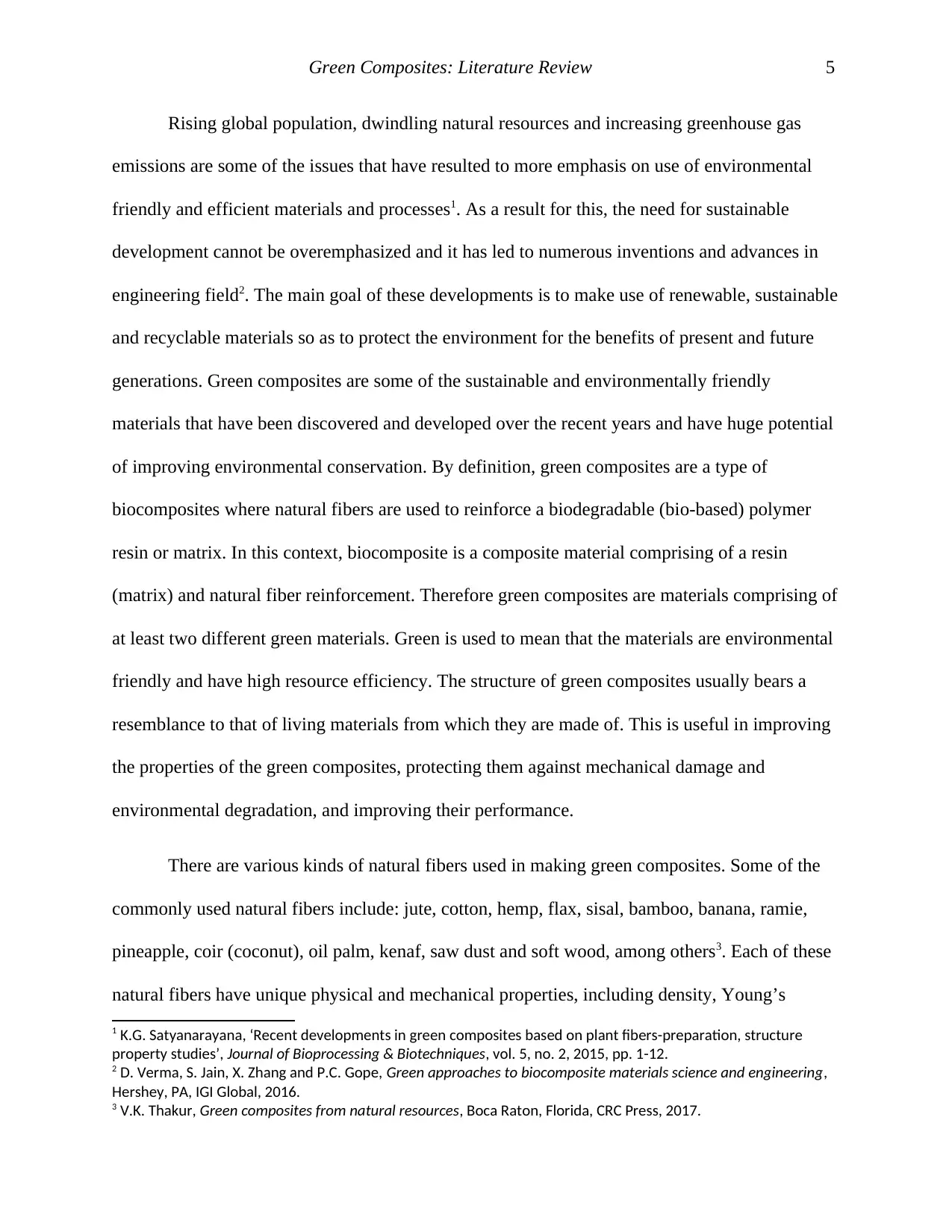
Green Composites: Literature Review 5
Rising global population, dwindling natural resources and increasing greenhouse gas
emissions are some of the issues that have resulted to more emphasis on use of environmental
friendly and efficient materials and processes1. As a result for this, the need for sustainable
development cannot be overemphasized and it has led to numerous inventions and advances in
engineering field2. The main goal of these developments is to make use of renewable, sustainable
and recyclable materials so as to protect the environment for the benefits of present and future
generations. Green composites are some of the sustainable and environmentally friendly
materials that have been discovered and developed over the recent years and have huge potential
of improving environmental conservation. By definition, green composites are a type of
biocomposites where natural fibers are used to reinforce a biodegradable (bio-based) polymer
resin or matrix. In this context, biocomposite is a composite material comprising of a resin
(matrix) and natural fiber reinforcement. Therefore green composites are materials comprising of
at least two different green materials. Green is used to mean that the materials are environmental
friendly and have high resource efficiency. The structure of green composites usually bears a
resemblance to that of living materials from which they are made of. This is useful in improving
the properties of the green composites, protecting them against mechanical damage and
environmental degradation, and improving their performance.
There are various kinds of natural fibers used in making green composites. Some of the
commonly used natural fibers include: jute, cotton, hemp, flax, sisal, bamboo, banana, ramie,
pineapple, coir (coconut), oil palm, kenaf, saw dust and soft wood, among others3. Each of these
natural fibers have unique physical and mechanical properties, including density, Young’s
1 K.G. Satyanarayana, ‘Recent developments in green composites based on plant fibers-preparation, structure
property studies’, Journal of Bioprocessing & Biotechniques, vol. 5, no. 2, 2015, pp. 1-12.
2 D. Verma, S. Jain, X. Zhang and P.C. Gope, Green approaches to biocomposite materials science and engineering,
Hershey, PA, IGI Global, 2016.
3 V.K. Thakur, Green composites from natural resources, Boca Raton, Florida, CRC Press, 2017.
Rising global population, dwindling natural resources and increasing greenhouse gas
emissions are some of the issues that have resulted to more emphasis on use of environmental
friendly and efficient materials and processes1. As a result for this, the need for sustainable
development cannot be overemphasized and it has led to numerous inventions and advances in
engineering field2. The main goal of these developments is to make use of renewable, sustainable
and recyclable materials so as to protect the environment for the benefits of present and future
generations. Green composites are some of the sustainable and environmentally friendly
materials that have been discovered and developed over the recent years and have huge potential
of improving environmental conservation. By definition, green composites are a type of
biocomposites where natural fibers are used to reinforce a biodegradable (bio-based) polymer
resin or matrix. In this context, biocomposite is a composite material comprising of a resin
(matrix) and natural fiber reinforcement. Therefore green composites are materials comprising of
at least two different green materials. Green is used to mean that the materials are environmental
friendly and have high resource efficiency. The structure of green composites usually bears a
resemblance to that of living materials from which they are made of. This is useful in improving
the properties of the green composites, protecting them against mechanical damage and
environmental degradation, and improving their performance.
There are various kinds of natural fibers used in making green composites. Some of the
commonly used natural fibers include: jute, cotton, hemp, flax, sisal, bamboo, banana, ramie,
pineapple, coir (coconut), oil palm, kenaf, saw dust and soft wood, among others3. Each of these
natural fibers have unique physical and mechanical properties, including density, Young’s
1 K.G. Satyanarayana, ‘Recent developments in green composites based on plant fibers-preparation, structure
property studies’, Journal of Bioprocessing & Biotechniques, vol. 5, no. 2, 2015, pp. 1-12.
2 D. Verma, S. Jain, X. Zhang and P.C. Gope, Green approaches to biocomposite materials science and engineering,
Hershey, PA, IGI Global, 2016.
3 V.K. Thakur, Green composites from natural resources, Boca Raton, Florida, CRC Press, 2017.
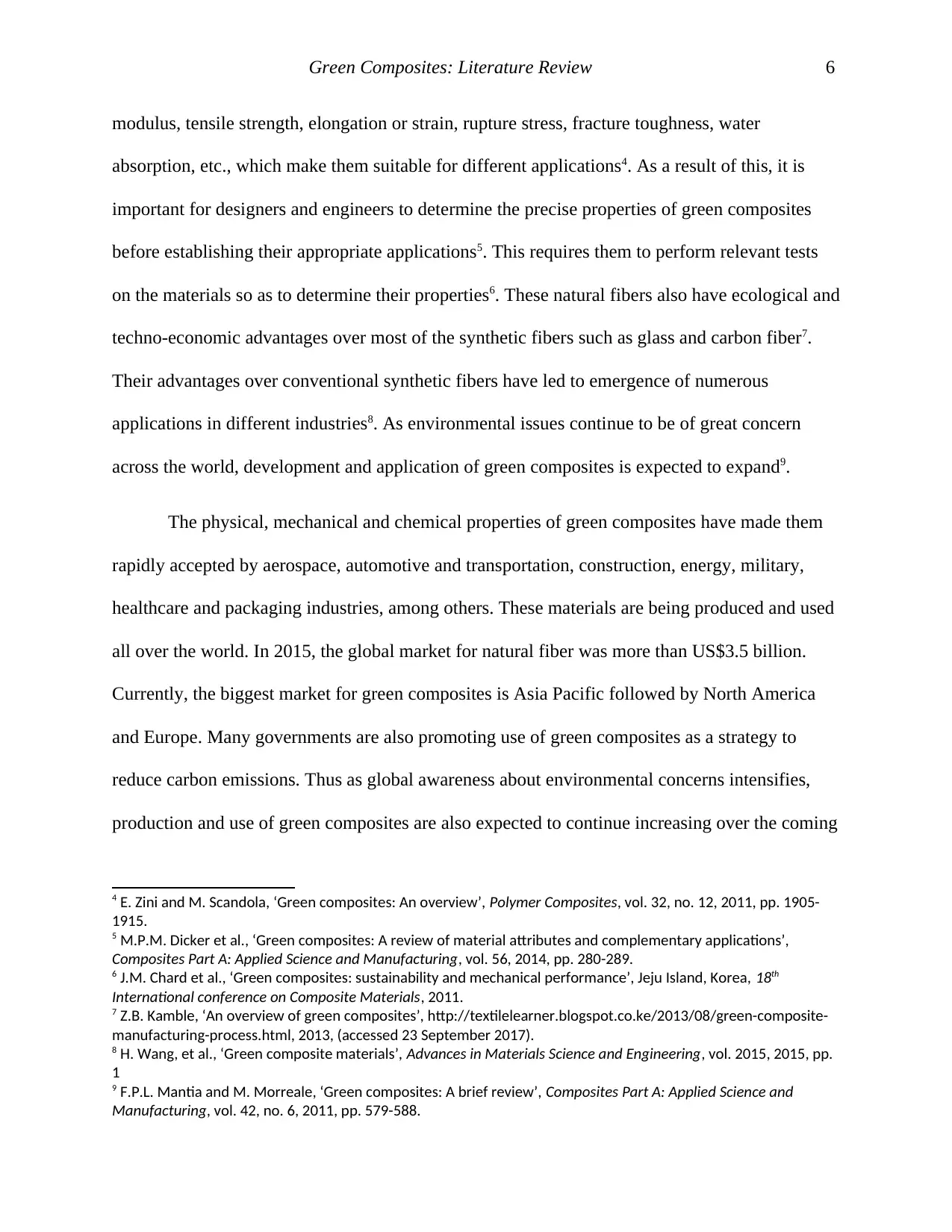
Green Composites: Literature Review 6
modulus, tensile strength, elongation or strain, rupture stress, fracture toughness, water
absorption, etc., which make them suitable for different applications4. As a result of this, it is
important for designers and engineers to determine the precise properties of green composites
before establishing their appropriate applications5. This requires them to perform relevant tests
on the materials so as to determine their properties6. These natural fibers also have ecological and
techno-economic advantages over most of the synthetic fibers such as glass and carbon fiber7.
Their advantages over conventional synthetic fibers have led to emergence of numerous
applications in different industries8. As environmental issues continue to be of great concern
across the world, development and application of green composites is expected to expand9.
The physical, mechanical and chemical properties of green composites have made them
rapidly accepted by aerospace, automotive and transportation, construction, energy, military,
healthcare and packaging industries, among others. These materials are being produced and used
all over the world. In 2015, the global market for natural fiber was more than US$3.5 billion.
Currently, the biggest market for green composites is Asia Pacific followed by North America
and Europe. Many governments are also promoting use of green composites as a strategy to
reduce carbon emissions. Thus as global awareness about environmental concerns intensifies,
production and use of green composites are also expected to continue increasing over the coming
4 E. Zini and M. Scandola, ‘Green composites: An overview’, Polymer Composites, vol. 32, no. 12, 2011, pp. 1905-
1915.
5 M.P.M. Dicker et al., ‘Green composites: A review of material attributes and complementary applications’,
Composites Part A: Applied Science and Manufacturing, vol. 56, 2014, pp. 280-289.
6 J.M. Chard et al., ‘Green composites: sustainability and mechanical performance’, Jeju Island, Korea, 18th
International conference on Composite Materials, 2011.
7 Z.B. Kamble, ‘An overview of green composites’, http://textilelearner.blogspot.co.ke/2013/08/green-composite-
manufacturing-process.html, 2013, (accessed 23 September 2017).
8 H. Wang, et al., ‘Green composite materials’, Advances in Materials Science and Engineering, vol. 2015, 2015, pp.
1
9 F.P.L. Mantia and M. Morreale, ‘Green composites: A brief review’, Composites Part A: Applied Science and
Manufacturing, vol. 42, no. 6, 2011, pp. 579-588.
modulus, tensile strength, elongation or strain, rupture stress, fracture toughness, water
absorption, etc., which make them suitable for different applications4. As a result of this, it is
important for designers and engineers to determine the precise properties of green composites
before establishing their appropriate applications5. This requires them to perform relevant tests
on the materials so as to determine their properties6. These natural fibers also have ecological and
techno-economic advantages over most of the synthetic fibers such as glass and carbon fiber7.
Their advantages over conventional synthetic fibers have led to emergence of numerous
applications in different industries8. As environmental issues continue to be of great concern
across the world, development and application of green composites is expected to expand9.
The physical, mechanical and chemical properties of green composites have made them
rapidly accepted by aerospace, automotive and transportation, construction, energy, military,
healthcare and packaging industries, among others. These materials are being produced and used
all over the world. In 2015, the global market for natural fiber was more than US$3.5 billion.
Currently, the biggest market for green composites is Asia Pacific followed by North America
and Europe. Many governments are also promoting use of green composites as a strategy to
reduce carbon emissions. Thus as global awareness about environmental concerns intensifies,
production and use of green composites are also expected to continue increasing over the coming
4 E. Zini and M. Scandola, ‘Green composites: An overview’, Polymer Composites, vol. 32, no. 12, 2011, pp. 1905-
1915.
5 M.P.M. Dicker et al., ‘Green composites: A review of material attributes and complementary applications’,
Composites Part A: Applied Science and Manufacturing, vol. 56, 2014, pp. 280-289.
6 J.M. Chard et al., ‘Green composites: sustainability and mechanical performance’, Jeju Island, Korea, 18th
International conference on Composite Materials, 2011.
7 Z.B. Kamble, ‘An overview of green composites’, http://textilelearner.blogspot.co.ke/2013/08/green-composite-
manufacturing-process.html, 2013, (accessed 23 September 2017).
8 H. Wang, et al., ‘Green composite materials’, Advances in Materials Science and Engineering, vol. 2015, 2015, pp.
1
9 F.P.L. Mantia and M. Morreale, ‘Green composites: A brief review’, Composites Part A: Applied Science and
Manufacturing, vol. 42, no. 6, 2011, pp. 579-588.
⊘ This is a preview!⊘
Do you want full access?
Subscribe today to unlock all pages.

Trusted by 1+ million students worldwide
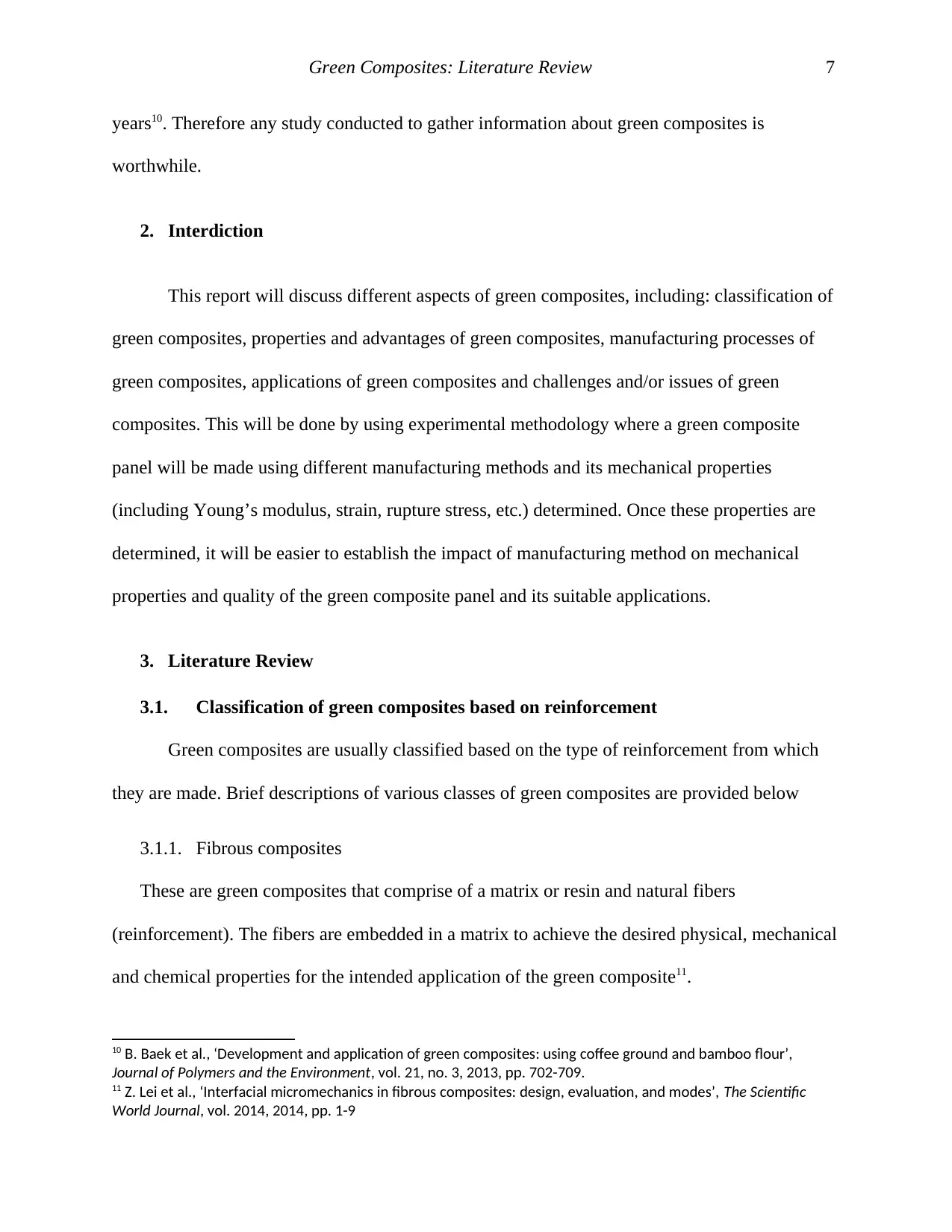
Green Composites: Literature Review 7
years10. Therefore any study conducted to gather information about green composites is
worthwhile.
2. Interdiction
This report will discuss different aspects of green composites, including: classification of
green composites, properties and advantages of green composites, manufacturing processes of
green composites, applications of green composites and challenges and/or issues of green
composites. This will be done by using experimental methodology where a green composite
panel will be made using different manufacturing methods and its mechanical properties
(including Young’s modulus, strain, rupture stress, etc.) determined. Once these properties are
determined, it will be easier to establish the impact of manufacturing method on mechanical
properties and quality of the green composite panel and its suitable applications.
3. Literature Review
3.1. Classification of green composites based on reinforcement
Green composites are usually classified based on the type of reinforcement from which
they are made. Brief descriptions of various classes of green composites are provided below
3.1.1. Fibrous composites
These are green composites that comprise of a matrix or resin and natural fibers
(reinforcement). The fibers are embedded in a matrix to achieve the desired physical, mechanical
and chemical properties for the intended application of the green composite11.
10 B. Baek et al., ‘Development and application of green composites: using coffee ground and bamboo flour’,
Journal of Polymers and the Environment, vol. 21, no. 3, 2013, pp. 702-709.
11 Z. Lei et al., ‘Interfacial micromechanics in fibrous composites: design, evaluation, and modes’, The Scientific
World Journal, vol. 2014, 2014, pp. 1-9
years10. Therefore any study conducted to gather information about green composites is
worthwhile.
2. Interdiction
This report will discuss different aspects of green composites, including: classification of
green composites, properties and advantages of green composites, manufacturing processes of
green composites, applications of green composites and challenges and/or issues of green
composites. This will be done by using experimental methodology where a green composite
panel will be made using different manufacturing methods and its mechanical properties
(including Young’s modulus, strain, rupture stress, etc.) determined. Once these properties are
determined, it will be easier to establish the impact of manufacturing method on mechanical
properties and quality of the green composite panel and its suitable applications.
3. Literature Review
3.1. Classification of green composites based on reinforcement
Green composites are usually classified based on the type of reinforcement from which
they are made. Brief descriptions of various classes of green composites are provided below
3.1.1. Fibrous composites
These are green composites that comprise of a matrix or resin and natural fibers
(reinforcement). The fibers are embedded in a matrix to achieve the desired physical, mechanical
and chemical properties for the intended application of the green composite11.
10 B. Baek et al., ‘Development and application of green composites: using coffee ground and bamboo flour’,
Journal of Polymers and the Environment, vol. 21, no. 3, 2013, pp. 702-709.
11 Z. Lei et al., ‘Interfacial micromechanics in fibrous composites: design, evaluation, and modes’, The Scientific
World Journal, vol. 2014, 2014, pp. 1-9
Paraphrase This Document
Need a fresh take? Get an instant paraphrase of this document with our AI Paraphraser
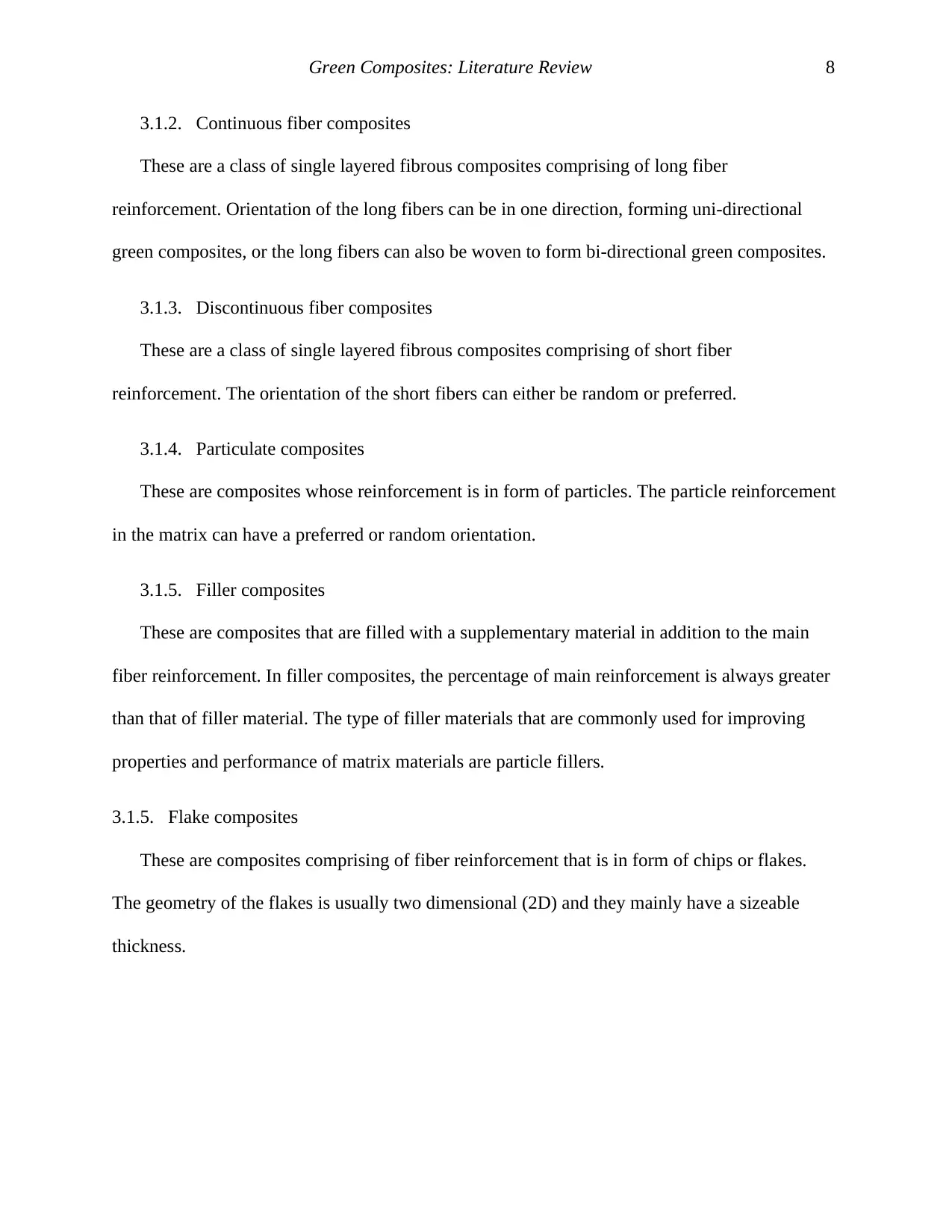
Green Composites: Literature Review 8
3.1.2. Continuous fiber composites
These are a class of single layered fibrous composites comprising of long fiber
reinforcement. Orientation of the long fibers can be in one direction, forming uni-directional
green composites, or the long fibers can also be woven to form bi-directional green composites.
3.1.3. Discontinuous fiber composites
These are a class of single layered fibrous composites comprising of short fiber
reinforcement. The orientation of the short fibers can either be random or preferred.
3.1.4. Particulate composites
These are composites whose reinforcement is in form of particles. The particle reinforcement
in the matrix can have a preferred or random orientation.
3.1.5. Filler composites
These are composites that are filled with a supplementary material in addition to the main
fiber reinforcement. In filler composites, the percentage of main reinforcement is always greater
than that of filler material. The type of filler materials that are commonly used for improving
properties and performance of matrix materials are particle fillers.
3.1.5. Flake composites
These are composites comprising of fiber reinforcement that is in form of chips or flakes.
The geometry of the flakes is usually two dimensional (2D) and they mainly have a sizeable
thickness.
3.1.2. Continuous fiber composites
These are a class of single layered fibrous composites comprising of long fiber
reinforcement. Orientation of the long fibers can be in one direction, forming uni-directional
green composites, or the long fibers can also be woven to form bi-directional green composites.
3.1.3. Discontinuous fiber composites
These are a class of single layered fibrous composites comprising of short fiber
reinforcement. The orientation of the short fibers can either be random or preferred.
3.1.4. Particulate composites
These are composites whose reinforcement is in form of particles. The particle reinforcement
in the matrix can have a preferred or random orientation.
3.1.5. Filler composites
These are composites that are filled with a supplementary material in addition to the main
fiber reinforcement. In filler composites, the percentage of main reinforcement is always greater
than that of filler material. The type of filler materials that are commonly used for improving
properties and performance of matrix materials are particle fillers.
3.1.5. Flake composites
These are composites comprising of fiber reinforcement that is in form of chips or flakes.
The geometry of the flakes is usually two dimensional (2D) and they mainly have a sizeable
thickness.
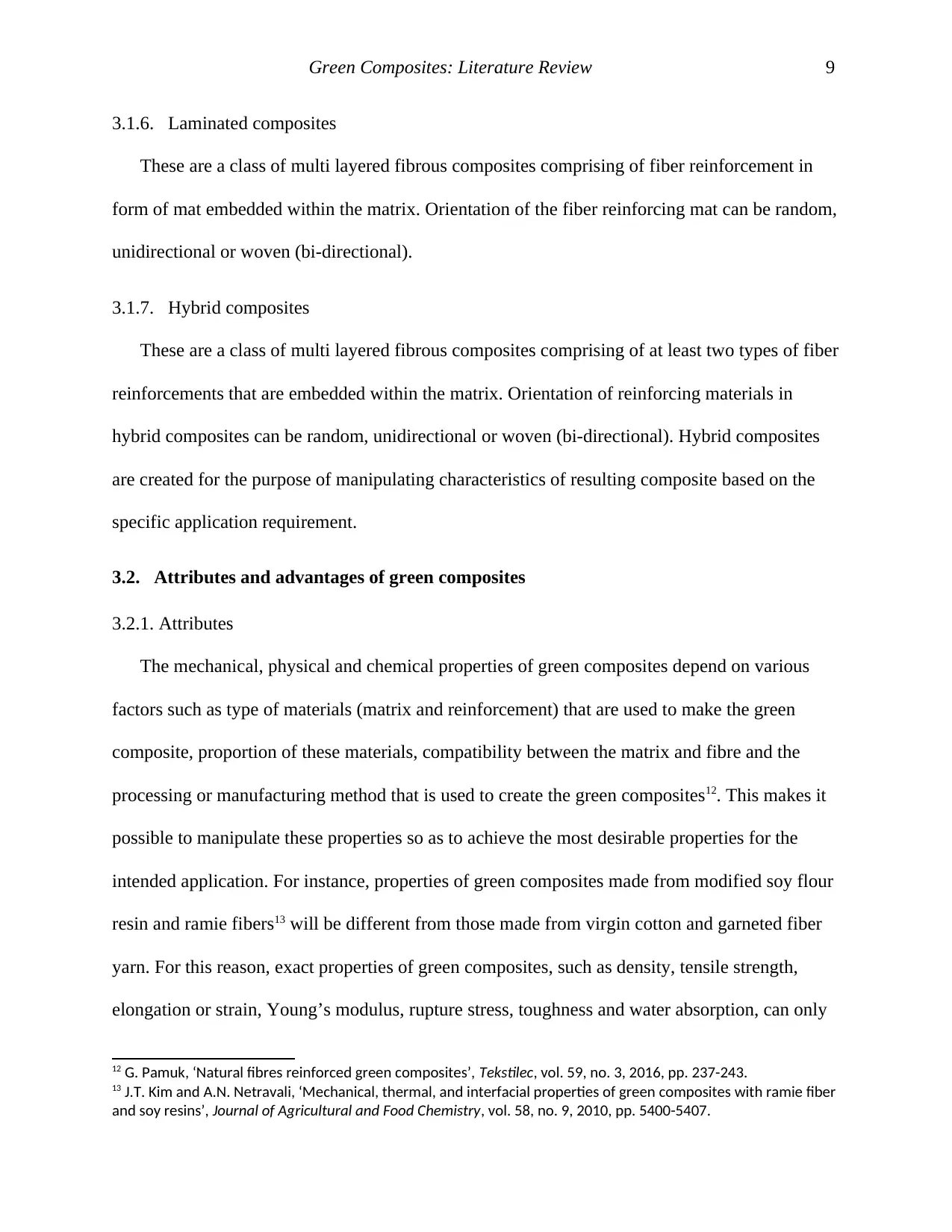
Green Composites: Literature Review 9
3.1.6. Laminated composites
These are a class of multi layered fibrous composites comprising of fiber reinforcement in
form of mat embedded within the matrix. Orientation of the fiber reinforcing mat can be random,
unidirectional or woven (bi-directional).
3.1.7. Hybrid composites
These are a class of multi layered fibrous composites comprising of at least two types of fiber
reinforcements that are embedded within the matrix. Orientation of reinforcing materials in
hybrid composites can be random, unidirectional or woven (bi-directional). Hybrid composites
are created for the purpose of manipulating characteristics of resulting composite based on the
specific application requirement.
3.2. Attributes and advantages of green composites
3.2.1. Attributes
The mechanical, physical and chemical properties of green composites depend on various
factors such as type of materials (matrix and reinforcement) that are used to make the green
composite, proportion of these materials, compatibility between the matrix and fibre and the
processing or manufacturing method that is used to create the green composites12. This makes it
possible to manipulate these properties so as to achieve the most desirable properties for the
intended application. For instance, properties of green composites made from modified soy flour
resin and ramie fibers13 will be different from those made from virgin cotton and garneted fiber
yarn. For this reason, exact properties of green composites, such as density, tensile strength,
elongation or strain, Young’s modulus, rupture stress, toughness and water absorption, can only
12 G. Pamuk, ‘Natural fibres reinforced green composites’, Tekstilec, vol. 59, no. 3, 2016, pp. 237-243.
13 J.T. Kim and A.N. Netravali, ‘Mechanical, thermal, and interfacial properties of green composites with ramie fiber
and soy resins’, Journal of Agricultural and Food Chemistry, vol. 58, no. 9, 2010, pp. 5400-5407.
3.1.6. Laminated composites
These are a class of multi layered fibrous composites comprising of fiber reinforcement in
form of mat embedded within the matrix. Orientation of the fiber reinforcing mat can be random,
unidirectional or woven (bi-directional).
3.1.7. Hybrid composites
These are a class of multi layered fibrous composites comprising of at least two types of fiber
reinforcements that are embedded within the matrix. Orientation of reinforcing materials in
hybrid composites can be random, unidirectional or woven (bi-directional). Hybrid composites
are created for the purpose of manipulating characteristics of resulting composite based on the
specific application requirement.
3.2. Attributes and advantages of green composites
3.2.1. Attributes
The mechanical, physical and chemical properties of green composites depend on various
factors such as type of materials (matrix and reinforcement) that are used to make the green
composite, proportion of these materials, compatibility between the matrix and fibre and the
processing or manufacturing method that is used to create the green composites12. This makes it
possible to manipulate these properties so as to achieve the most desirable properties for the
intended application. For instance, properties of green composites made from modified soy flour
resin and ramie fibers13 will be different from those made from virgin cotton and garneted fiber
yarn. For this reason, exact properties of green composites, such as density, tensile strength,
elongation or strain, Young’s modulus, rupture stress, toughness and water absorption, can only
12 G. Pamuk, ‘Natural fibres reinforced green composites’, Tekstilec, vol. 59, no. 3, 2016, pp. 237-243.
13 J.T. Kim and A.N. Netravali, ‘Mechanical, thermal, and interfacial properties of green composites with ramie fiber
and soy resins’, Journal of Agricultural and Food Chemistry, vol. 58, no. 9, 2010, pp. 5400-5407.
⊘ This is a preview!⊘
Do you want full access?
Subscribe today to unlock all pages.

Trusted by 1+ million students worldwide
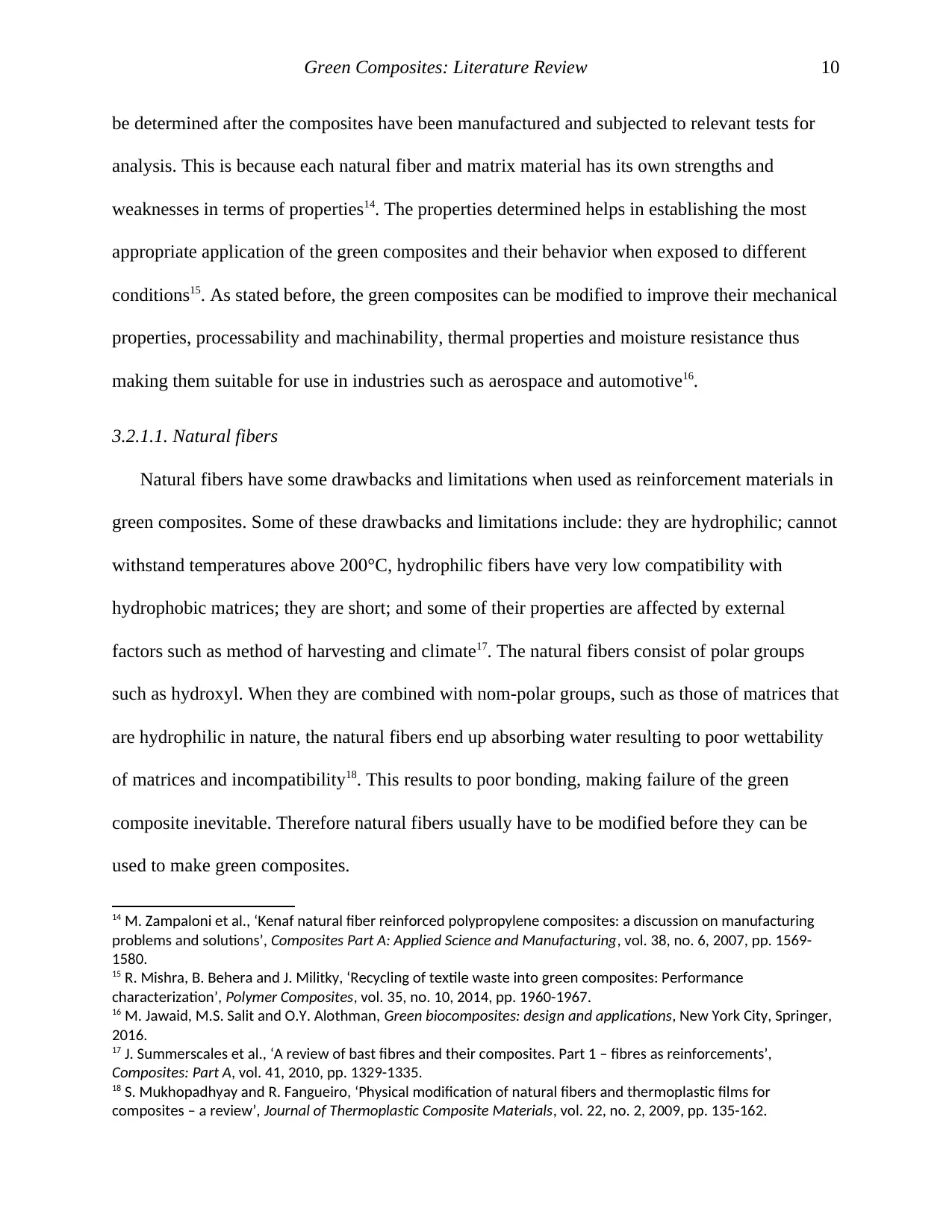
Green Composites: Literature Review 10
be determined after the composites have been manufactured and subjected to relevant tests for
analysis. This is because each natural fiber and matrix material has its own strengths and
weaknesses in terms of properties14. The properties determined helps in establishing the most
appropriate application of the green composites and their behavior when exposed to different
conditions15. As stated before, the green composites can be modified to improve their mechanical
properties, processability and machinability, thermal properties and moisture resistance thus
making them suitable for use in industries such as aerospace and automotive16.
3.2.1.1. Natural fibers
Natural fibers have some drawbacks and limitations when used as reinforcement materials in
green composites. Some of these drawbacks and limitations include: they are hydrophilic; cannot
withstand temperatures above 200°C, hydrophilic fibers have very low compatibility with
hydrophobic matrices; they are short; and some of their properties are affected by external
factors such as method of harvesting and climate17. The natural fibers consist of polar groups
such as hydroxyl. When they are combined with nom-polar groups, such as those of matrices that
are hydrophilic in nature, the natural fibers end up absorbing water resulting to poor wettability
of matrices and incompatibility18. This results to poor bonding, making failure of the green
composite inevitable. Therefore natural fibers usually have to be modified before they can be
used to make green composites.
14 M. Zampaloni et al., ‘Kenaf natural fiber reinforced polypropylene composites: a discussion on manufacturing
problems and solutions’, Composites Part A: Applied Science and Manufacturing, vol. 38, no. 6, 2007, pp. 1569-
1580.
15 R. Mishra, B. Behera and J. Militky, ‘Recycling of textile waste into green composites: Performance
characterization’, Polymer Composites, vol. 35, no. 10, 2014, pp. 1960-1967.
16 M. Jawaid, M.S. Salit and O.Y. Alothman, Green biocomposites: design and applications, New York City, Springer,
2016.
17 J. Summerscales et al., ‘A review of bast fibres and their composites. Part 1 – fibres as reinforcements’,
Composites: Part A, vol. 41, 2010, pp. 1329-1335.
18 S. Mukhopadhyay and R. Fangueiro, ‘Physical modification of natural fibers and thermoplastic films for
composites – a review’, Journal of Thermoplastic Composite Materials, vol. 22, no. 2, 2009, pp. 135-162.
be determined after the composites have been manufactured and subjected to relevant tests for
analysis. This is because each natural fiber and matrix material has its own strengths and
weaknesses in terms of properties14. The properties determined helps in establishing the most
appropriate application of the green composites and their behavior when exposed to different
conditions15. As stated before, the green composites can be modified to improve their mechanical
properties, processability and machinability, thermal properties and moisture resistance thus
making them suitable for use in industries such as aerospace and automotive16.
3.2.1.1. Natural fibers
Natural fibers have some drawbacks and limitations when used as reinforcement materials in
green composites. Some of these drawbacks and limitations include: they are hydrophilic; cannot
withstand temperatures above 200°C, hydrophilic fibers have very low compatibility with
hydrophobic matrices; they are short; and some of their properties are affected by external
factors such as method of harvesting and climate17. The natural fibers consist of polar groups
such as hydroxyl. When they are combined with nom-polar groups, such as those of matrices that
are hydrophilic in nature, the natural fibers end up absorbing water resulting to poor wettability
of matrices and incompatibility18. This results to poor bonding, making failure of the green
composite inevitable. Therefore natural fibers usually have to be modified before they can be
used to make green composites.
14 M. Zampaloni et al., ‘Kenaf natural fiber reinforced polypropylene composites: a discussion on manufacturing
problems and solutions’, Composites Part A: Applied Science and Manufacturing, vol. 38, no. 6, 2007, pp. 1569-
1580.
15 R. Mishra, B. Behera and J. Militky, ‘Recycling of textile waste into green composites: Performance
characterization’, Polymer Composites, vol. 35, no. 10, 2014, pp. 1960-1967.
16 M. Jawaid, M.S. Salit and O.Y. Alothman, Green biocomposites: design and applications, New York City, Springer,
2016.
17 J. Summerscales et al., ‘A review of bast fibres and their composites. Part 1 – fibres as reinforcements’,
Composites: Part A, vol. 41, 2010, pp. 1329-1335.
18 S. Mukhopadhyay and R. Fangueiro, ‘Physical modification of natural fibers and thermoplastic films for
composites – a review’, Journal of Thermoplastic Composite Materials, vol. 22, no. 2, 2009, pp. 135-162.
Paraphrase This Document
Need a fresh take? Get an instant paraphrase of this document with our AI Paraphraser
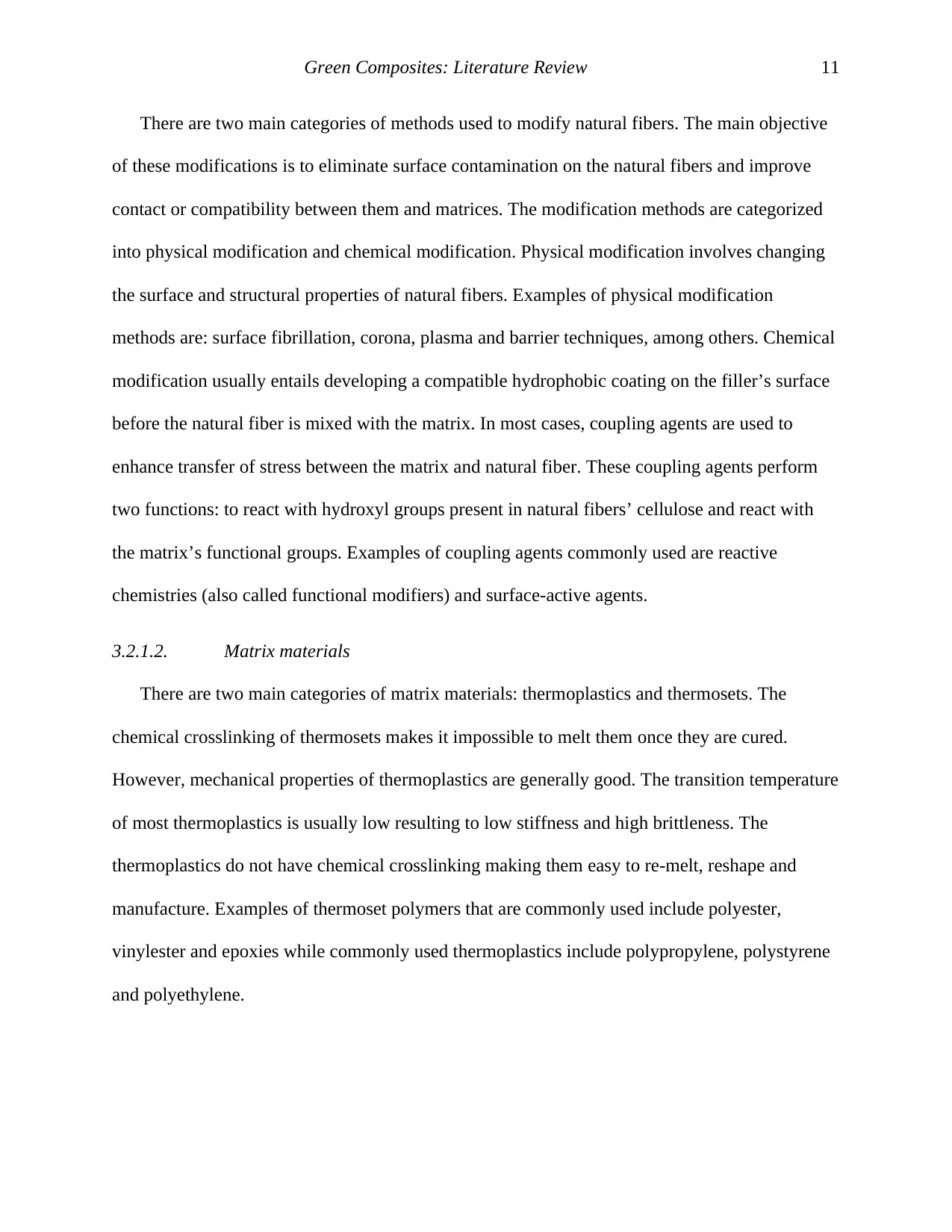
Green Composites: Literature Review 11
There are two main categories of methods used to modify natural fibers. The main objective
of these modifications is to eliminate surface contamination on the natural fibers and improve
contact or compatibility between them and matrices. The modification methods are categorized
into physical modification and chemical modification. Physical modification involves changing
the surface and structural properties of natural fibers. Examples of physical modification
methods are: surface fibrillation, corona, plasma and barrier techniques, among others. Chemical
modification usually entails developing a compatible hydrophobic coating on the filler’s surface
before the natural fiber is mixed with the matrix. In most cases, coupling agents are used to
enhance transfer of stress between the matrix and natural fiber. These coupling agents perform
two functions: to react with hydroxyl groups present in natural fibers’ cellulose and react with
the matrix’s functional groups. Examples of coupling agents commonly used are reactive
chemistries (also called functional modifiers) and surface-active agents.
3.2.1.2. Matrix materials
There are two main categories of matrix materials: thermoplastics and thermosets. The
chemical crosslinking of thermosets makes it impossible to melt them once they are cured.
However, mechanical properties of thermoplastics are generally good. The transition temperature
of most thermoplastics is usually low resulting to low stiffness and high brittleness. The
thermoplastics do not have chemical crosslinking making them easy to re-melt, reshape and
manufacture. Examples of thermoset polymers that are commonly used include polyester,
vinylester and epoxies while commonly used thermoplastics include polypropylene, polystyrene
and polyethylene.
There are two main categories of methods used to modify natural fibers. The main objective
of these modifications is to eliminate surface contamination on the natural fibers and improve
contact or compatibility between them and matrices. The modification methods are categorized
into physical modification and chemical modification. Physical modification involves changing
the surface and structural properties of natural fibers. Examples of physical modification
methods are: surface fibrillation, corona, plasma and barrier techniques, among others. Chemical
modification usually entails developing a compatible hydrophobic coating on the filler’s surface
before the natural fiber is mixed with the matrix. In most cases, coupling agents are used to
enhance transfer of stress between the matrix and natural fiber. These coupling agents perform
two functions: to react with hydroxyl groups present in natural fibers’ cellulose and react with
the matrix’s functional groups. Examples of coupling agents commonly used are reactive
chemistries (also called functional modifiers) and surface-active agents.
3.2.1.2. Matrix materials
There are two main categories of matrix materials: thermoplastics and thermosets. The
chemical crosslinking of thermosets makes it impossible to melt them once they are cured.
However, mechanical properties of thermoplastics are generally good. The transition temperature
of most thermoplastics is usually low resulting to low stiffness and high brittleness. The
thermoplastics do not have chemical crosslinking making them easy to re-melt, reshape and
manufacture. Examples of thermoset polymers that are commonly used include polyester,
vinylester and epoxies while commonly used thermoplastics include polypropylene, polystyrene
and polyethylene.

Green Composites: Literature Review 12
3.2.2. Advantages
The popularity of green composites is rapidly increasing across various sectors mainly
because of the exceptional properties and potential benefits of these materials19. Some of the
advantages of green composites are as follows:
Wide-ranging properties and applications: there are various kinds of natural fibers and matrix
materials, each with unique properties. Natural fibers are acquired from varied natural sources.
The properties of these materials are influenced by factors like climate, plant location, crop
variety, soil quality, seed density, fertilization, harvest timing and location of fiber on the plant,
among others20. Matrix materials also have different properties. When these materials are
combined, they create green composites with wide-ranging mechanical, physical and chemical
properties that are suitable for a variety of applications such as in construction, automotive,
aerospace, military, healthcare, electronics and energy sectors.
Non-toxicity: natural fibers used in making green composites are typically non-toxic21, which
reduces their environmental impacts throughout their lifecycle. Several studies have shown that
natural fibers have far less heavy metals, carcinogenic substances and human toxins than
synthetic fibers such as glass fiber. Therefore green composites have near zero toxicity hence
harmless to humans and ecosystems.
Low cost: natural fibers’ cost is generally lower than that of synthetic fibers22. However,
most biopolymers and matrix materials cost more than synthetic fibers. One of the techniques
19 A.A. Singh, S. Afrin and Z. Karim, ‘Green composites: versatile material for future’, in Green biocomposites (green
energy and technology), New York City, Springer, 2017, pp. 29-44.
20 D.B. Dittenberg and H.V.S. GangaRao, ‘Critical review of recent publications on use of natural composites in
infrastructure’, Composites Part A: Applied Science and Manufacturing, vol. 43, 2012, pp. 1905-1915.
21 E. Zini and M. Scandola, ‘Green composites: an overview’, Polymer Composites, vol. 32, 2011, pp. 1905-1915.
22 S.K. Ramamoorthya et al., ‘A review of natural fibers used in biocomposites: plant, animal and regenerated
cellulose fibers’, Polymer Reviews, vol. 55, pp. 107-162.
3.2.2. Advantages
The popularity of green composites is rapidly increasing across various sectors mainly
because of the exceptional properties and potential benefits of these materials19. Some of the
advantages of green composites are as follows:
Wide-ranging properties and applications: there are various kinds of natural fibers and matrix
materials, each with unique properties. Natural fibers are acquired from varied natural sources.
The properties of these materials are influenced by factors like climate, plant location, crop
variety, soil quality, seed density, fertilization, harvest timing and location of fiber on the plant,
among others20. Matrix materials also have different properties. When these materials are
combined, they create green composites with wide-ranging mechanical, physical and chemical
properties that are suitable for a variety of applications such as in construction, automotive,
aerospace, military, healthcare, electronics and energy sectors.
Non-toxicity: natural fibers used in making green composites are typically non-toxic21, which
reduces their environmental impacts throughout their lifecycle. Several studies have shown that
natural fibers have far less heavy metals, carcinogenic substances and human toxins than
synthetic fibers such as glass fiber. Therefore green composites have near zero toxicity hence
harmless to humans and ecosystems.
Low cost: natural fibers’ cost is generally lower than that of synthetic fibers22. However,
most biopolymers and matrix materials cost more than synthetic fibers. One of the techniques
19 A.A. Singh, S. Afrin and Z. Karim, ‘Green composites: versatile material for future’, in Green biocomposites (green
energy and technology), New York City, Springer, 2017, pp. 29-44.
20 D.B. Dittenberg and H.V.S. GangaRao, ‘Critical review of recent publications on use of natural composites in
infrastructure’, Composites Part A: Applied Science and Manufacturing, vol. 43, 2012, pp. 1905-1915.
21 E. Zini and M. Scandola, ‘Green composites: an overview’, Polymer Composites, vol. 32, 2011, pp. 1905-1915.
22 S.K. Ramamoorthya et al., ‘A review of natural fibers used in biocomposites: plant, animal and regenerated
cellulose fibers’, Polymer Reviews, vol. 55, pp. 107-162.
⊘ This is a preview!⊘
Do you want full access?
Subscribe today to unlock all pages.

Trusted by 1+ million students worldwide
1 out of 29
Your All-in-One AI-Powered Toolkit for Academic Success.
+13062052269
info@desklib.com
Available 24*7 on WhatsApp / Email
![[object Object]](/_next/static/media/star-bottom.7253800d.svg)
Unlock your academic potential
Copyright © 2020–2025 A2Z Services. All Rights Reserved. Developed and managed by ZUCOL.